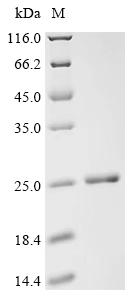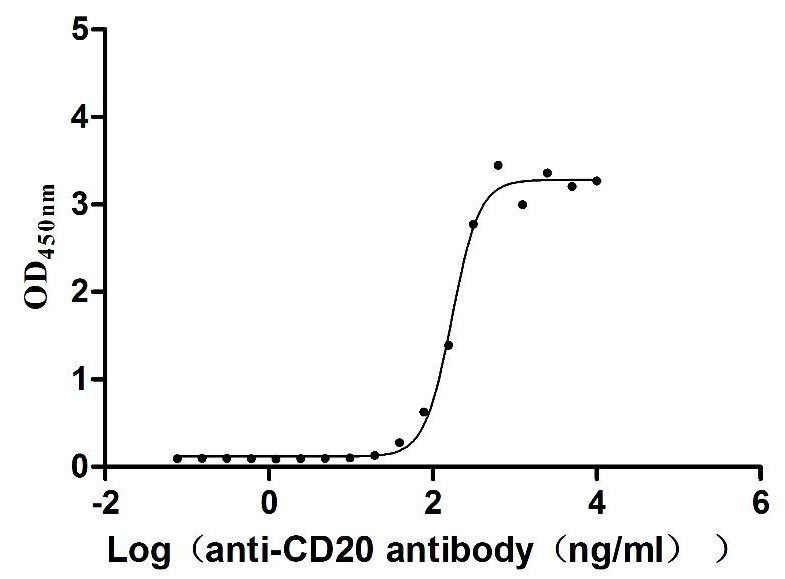Recombinant Qbeta virus Capsid protein
-
中文名称:Recombinant Qbeta virus Capsid protein
-
货号:CSB-EP886842ELC
-
规格:¥2328
-
图片:
-
其他:
产品详情
-
纯度:Greater than 95% as determined by SDS-PAGE.
-
生物活性:Not Test
-
基因名:N/A
-
Uniprot No.:
-
别名:CP;Coat protein
-
种属:Qbeta virus (strain MX1)
-
蛋白长度:Full Length of Mature Protein
-
来源:E.coli
-
分子量:21.0 kDa
-
表达区域:2-133aa
-
氨基酸序列AKLQAITLSGIGKNGDVTLNLNPRGVNPTNGVAALSEAGAVPALEKRVTISVSQPSRNRKNYKVQVKIQNPTSCTASGTCDPSVTRSAYADVTFSFTQYSTDEERALVRTELKALLADPMLIDAIDNLNPAY
Note: The complete sequence including tag sequence, target protein sequence and linker sequence could be provided upon request. -
蛋白标签:C-terminal 6xHis-tagged
-
产品提供形式:Liquid or Lyophilized powder
Note: We will preferentially ship the format that we have in stock, however, if you have any special requirement for the format, please remark your requirement when placing the order, we will prepare according to your demand. -
缓冲液:If the delivery form is liquid, the default storage buffer is Tris/PBS-based buffer, 5%-50% glycerol. If the delivery form is lyophilized powder, the buffer before lyophilization is Tris/PBS-based buffer, 6% Trehalose.
-
复溶:We recommend that this vial be briefly centrifuged prior to opening to bring the contents to the bottom. Please reconstitute protein in deionized sterile water to a concentration of 0.1-1.0 mg/mL.We recommend to add 5-50% of glycerol (final concentration) and aliquot for long-term storage at -20℃/-80℃. Our default final concentration of glycerol is 50%. Customers could use it as reference.
-
储存条件:Store at -20°C/-80°C upon receipt, aliquoting is necessary for mutiple use. Avoid repeated freeze-thaw cycles.
-
保质期:The shelf life is related to many factors, storage state, buffer ingredients, storage temperature and the stability of the protein itself.
Generally, the shelf life of liquid form is 6 months at -20°C/-80°C. The shelf life of lyophilized form is 12 months at -20°C/-80°C. -
货期:Delivery time may differ from different purchasing way or location, please kindly consult your local distributors for specific delivery time.
-
注意事项:Repeated freezing and thawing is not recommended. Store working aliquots at 4℃ for up to one week.
-
Datasheet & COA:Please contact us to get it.
相关产品
靶点详情
-
功能:Capsid protein self-assembles to form an icosahedral capsid with a T=3 symmetry, about 26 nm in diameter, and consisting of 89 capsid proteins dimers (178 capsid proteins). Involved in viral genome encapsidation through the interaction between a capsid protein dimer and the multiple packaging signals present in the RNA genome. Binding of the capsid proteins to the viral RNA induces a conformational change required for efficient T=3 shell formation. The capsid contains also 1 copy of the A2 maturation protein.; Acts as a translational repressor of viral replicase synthesis late in infection. This latter function is the result of capsid protein interaction with an RNA hairpin which contains the replicase ribosome-binding site.
-
亚细胞定位:Virion.
-
数据库链接:
KEGG: vg:1261502
Most popular with customers
-
Recombinant Human IGF-like family receptor 1 (IGFLR1), partial (Active)
Express system: Mammalian cell
Species: Homo sapiens (Human)
-
Recombinant Dog B-lymphocyte antigen CD20 (MS4A1)-VLPs (Active)
Express system: Mammalian cell
Species: Canis lupus familiaris (Dog) (Canis familiaris)
-
Recombinant Macaca fascicularis CD44 antigen (CD44), partial (Active)
Express system: Mammalian cell
Species: Macaca fascicularis (Crab-eating macaque) (Cynomolgus monkey)
-
Express system: Mammalian cell
Species: Homo sapiens (Human)
-
Recombinant Human Desmoglein-2 (DSG2), partial (Active)
Express system: Mammalian cell
Species: Homo sapiens (Human)
-
Recombinant Human Transferrin receptor protein 1 (TFRC), partial (Active)
Express system: Mammalian cell
Species: Homo sapiens (Human)
-
Recombinant Human Carcinoembryonic antigen-related cell adhesion molecule 8(CEACAM8) (Active)
Express system: Mammalian cell
Species: Homo sapiens (Human)
-
Recombinant Human C-C chemokine receptor type 6(CCR6)-VLPs (Active)
Express system: Mammalian cell
Species: Homo sapiens (Human)





















